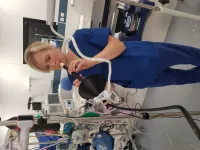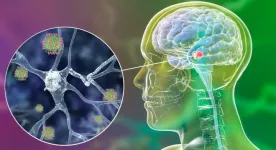(Press-News.org) A new corona test developed at the University Hospital Bonn can analyze a large number of swabs simultaneously using sequencing technology and has a similarly high sensitivity as the common qPCR test. The innovative method offers great potential, especially for systematic testing in daycare centers, schools or companies. Today, the results of the study on the new Corona test have been published in the renowned journal "Nature Biotechnology".
Bonn, 6/29/2021 - In addition to vaccination, systematic testing of the population remains of central importance in order to effectively monitor and contain the spread of infections during the Coronavirus pandemic. Only in this way can the spread of the virus be effectively monitored and contained through targeted measures.
The innovative corona test "LAMP-Seq", which has been developed at the University Hospital Bonn (UKB), offers the possibility to test many people regularly for the SARS-CoV-2 virus. In this way, infections can be detected at an early stage and corresponding chains of infection can be interrupted quickly. "Our corona test "LAMP-Seq" can detect about 100 times lower amounts of virus than current rapid antigen tests and is almost as sensitive and specific as the common qPCR test" describes Prof. Dr. Jonathan Schmid-Burgk from the Institute of Clinical Chemistry and Clinical Pharmacology of the UKB the characteristics of the test procedure, which was developed interdisciplinary with other researchers at the UKB.
"Added to this is the high scalability of the test. By using sequencing machines, thousands of samples can be analyzed simultaneously," said Schmid-Burgk, who was appointed to the University of Bonn from the Broad Institute of MIT and Harvard in early 2020. The LAMP-Seq method detects not only corona infections with the original SARS-CoV-2 virus, but also the novel variants of concern alpha to delta.
Members of the ImmunoSensation2 cluster of excellence, the Institute of Hygiene and Public Health, Life&Brain GmbH and Bundeswehr Central Hospital Koblenz were among those involved in the project.
For the "LAMP-Seq" test, the Bonn scientists have adapted the already established LAMP method ("Loop-mediated Isothermal Amplification" - propagation of the viral genome at a constant temperature) and made it compatible with sequencing machines used for biomedical research. As a result, many samples can be analyzed simultaneously in a high-throughput procedure. Before thousands of samples are analyzed together in a sequencing run, each individual sample is linked to a molecular barcode. This barcode ensures that each sample can be assigned without doubt, even after thousands of samples have been pooled. "Retesting of the entire pool in case of a positive test result is therefore no longer necessary" says Dr. Kerstin Ludwig, Emmy-Noether group leader at the Institute of Human Genetics. This technology significantly reduces the cost per test in comparison to the qPCR test and makes the "LAMP-Seq" procedure a scalable corona mass test.
"With its high throughput and sensitivity, the "LAMP-Seq" test can make a significant contribution to the screening of undetected infections. Especially in schools or companies, where many people regularly meet, the corona test is ideal to systematically and preventively monitor the occurrence of infections" describes Ludwig, the co-developer of the test procedure, the possible application scenarios of the "LAMP-Seq" test.
Prof. Wolfgang Holzgreve, Medical Director and CEO of the UKB, explains the benefits of the new test for corona surveillance as follows: "In order to effectively contain a pandemic, infected people must be found before they infect others. To achieve this goal, we need mass screenings with the highest sensitivity that can give us a detailed picture of existing chains of infection. This is exactly what the corona test "LAMP-Seq" developed at UKB is suited for."
Even smaller models of the sequencing machines used are capable of analyzing around 10,000 samples in a single run (duration: around ten to twelve hours). This virtually eliminates laboratory capacity as a limiting factor in testing.
In several large studies (including school and employee testing) with a total of around 20,000 tests, the Bonn scientists have extensively tested, optimized and successfully validated the entire upstream and downstream logistics, from sample collection by throat swabs to fully digital feedback of the test results. The documentation of the study results recently passed an independent peer review process and was published today in the renowned journal Nature Biotechnology.
While the Bonn scientists have currently focused their innovative method entirely on SARS-CoV-2 testing, "LAMP-Seq" can also be used in the future for differential diagnostics in testing for other viruses such as influenza A and can also be quickly adapted to other viruses.
The scientists are currently working on CE certification in order to make the "LAMP-Seq" test available internationally in the near future. Until this approval is obtained, the technically and scientifically fully validated "LAMP-Seq" method will continue to be used for pilot testing.
INFORMATION:
The scientific team received financial support from the German Federal Ministry of Education and Research BMBF within the framework of the "Bundesweites Forschungsnetz Angewandte Surveillance und Testung" (B-FAST).
Publication: Kerstin U. Ludwig, Ricarda M. Schmithausen, David Li, Max L. Jacobs, Ronja Hollstein, Katja Blumenstock, Jana Liebing, Miko?aj S?abicki, Amir Ben-Shmuel, Ofir Israeli, Shay Weiss, Thomas S. Ebert, Nir Paran, Wibke Rüdiger, Gero Wilbring, David Feldman, Bärbel Lippke, Nina Ishorst, Lara M. Hochfeld, Eva C. Beins, Ines H. Kaltheuner, Maximilian Schmitz, Aliona Wöhler, Manuel Döhla, Esther Sib, Marius Jentzsch, Jacob D. Borrajo, Jonathan Strecker, Julia Reinhardt, Brian Cleary, Matthias Geyer, Michael Hölzel, Rhiannon Macrae, Markus M. Nöthen, Per Hoffmann, Martin Exner, Aviv Regev, Feng Zhang, Jonathan L. Schmid-Burgk: "LAMP-Seq enables sensitive, multiplexed COVID-19 diagnostics using molecular barcoding", Nature Biotechnology 2021, Internet: https://www.nature.com/articles/s41587-021-00966-9
Press contact:
Felix Heyder
University Hospital Bonn
+49 228 / 287-11904
felix.heyder@ukbonn.de
Crystallization is one of the most fundamental processes found in nature - and it's what gives minerals, gems, metals, and even proteins their structure.
In the past couple of decades, scientists have tried to uncover how natural crystals self-assemble and grow - and their pioneering work has led to some exciting new technologies - from the quantum dots behind colorful QLED TV displays, to peptoids, a protein-mimic that has inspired dozens of biotech breakthroughs.
Now, a research team led by scientists at the Department of Energy's Lawrence Berkeley National Laboratory (Berkeley Lab) and UC Berkeley has developed a nanoparticle composite that grows ...
The electronic properties of graphene can be specifically modified by stretching the material evenly, say researchers at the University of Basel. These results open the door to the development of new types of electronic components.
Graphene consists of a single layer of carbon atoms arranged in a hexagonal lattice. The material is very flexible and has excellent electronic properties, making it attractive for numerous applications - electronic components in particular.
Researchers led by Professor Christian Schönenberger at the Swiss Nanoscience Institute and the Department of Physics at the University of Basel have now studied how the material's ...
Mineral resources from Chile are of great importance to Germany. According to statistics from the World Bank, thousands of tons of valuable minerals are imported from the South American country every year, including raw materials for lithium-ion batteries. But their extraction causes ecological and social problems: "The use of the limited freshwater resources in northern Chile for mining regularly fuels conflicts with the local population," says Professor Thomas Kohl from KIT's Institute of Applied Geosciences (AGW). "Northern Chile is one of the driest regions on earth, but has extensive geothermal resources. With a novel type of plant, it is not only possible to generate electricity in a climate-friendly way, but also to extract ...
When positioned strategically, garment seams sewn with conductive yarn can be used to accurately track body motion, according to computer scientists at the University of Bath in the UK. Best of all, these charged seams are able to respond to subtle movements that aren't picked up by popular fitness trackers, such as watches and wristbands.
In a new study, the Bath researchers found that clothing made with conductive seams can be analysed to identify the wearer's movements.
PhD student Olivia Ruston, who presented the work at the ACM Designing Interactive Systems conference this month, said: "There are lots of potential applications for conductive yarn in any activity where you want to identify and improve ...
Mice are an important animal model of human vision due to the powerful genetic tools available in this species. However, mouse vision was thought to be different to that of humans because humans have a region of the retina specialized for fine details called the 'fovea' whereas mice do not. Researchers from the Netherlands Institute of Neuroscience (NIN) have shown that the visual cortex of mice does contain a region of enhanced visual sensitivity dubbed the 'focea', making the mouse a better model of human vision than previously expected. The findings were published ...
Lithia, Florida -- June 29, 2021 -- Surgical resident training has traditionally occurred in a master-apprentice-type relationship, with graduated responsibilities until trainees are expected to perform procedures on their own. Given recent changes in the health care system, including reduced operating room time, increased difficulty of procedures and working hour restrictions, there is less time for residents to learn using traditional methods.
Researchers from the University of Manitoba and the Pan Am Clinic recently published a paper in the journal Arthroscopy, Sports Medicine, ...
Aerosol generated by playing woodwind and brass instruments is less than that produced when vocalising (speaking and singing) and is no different than a person breathing, new research has found. The findings, published online in the journal Aerosol Science and Technology, could be crucial to developing a roadmap for lifting COVID-19 restrictions in the performing arts, which have been significantly restricted since the start of the pandemic.
The research project, known as PERFORM (ParticulatE Respiratory Matter to InForm Guidance for the Safe Distancing of PerfOrmeRs in a COVID-19 PandeMic), was supported by Public Health England, the Department for Digital, Culture, Media and Sport (DCMS), and UKRI and was carried out by a collaborative team from ...
The death of neurons specialised in the synthesis of dopamine, one of the brain's main neurotransmissors, deteriorates the motor and cognitive capacities of those with Parkinson's disease. The loss of these neurons is related to alpha-synuclein aggregation. Recent studies show that oligomers, the initial aggregates of this protein, are the most pathogenic forms of α-synuclein and are responsible for the spreading of the disease in the brain.
Therefore, one of the more promising approaches in fighting this disorder consists in neutralising these oligomers and, thus, slow down the pathological progression. ...
During the last twenty years, the trading in stock markets has undergone significant changes. Researchers from the University of Turku and the University of Palermo have investigated the role of high-frequency traders in the markets.
Technological evolution and innovations both in the technology used by stock exchanges and the resources of the traders using their services have made faster trading possible. As a result, high-frequency trading in sub millisecond scale has increased.
However, not everyone has the opportunity to use high-frequency trading, and generally, the scales can be anything from microseconds to tens of thousands of seconds. The role of high-frequency traders has given rise to broad debate over ...
HERSHEY, Pa. -- A new study by researchers at Penn State College of Medicine indicates that people living with human immunodeficiency virus (HIV) and acquired immune deficiency syndrome (AIDS) -- approximately 38 million worldwide -- are more likely to have suicidal thoughts and die from suicide than members of the general population. The researchers said that despite significant medical advancements related to HIV treatment and patients' quality of life, risk of suicide in these patients is high and health care providers should prioritize mental health screenings in this population.
According to the World Health Organization, roughly 800,000 people worldwide die from suicide annually. Among ...






